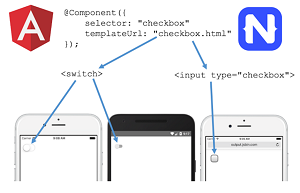News
NativeScript 2.0 Courts AngularJS Developers for Cross-Platform Mobile Apps
- By David Ramel
- May 4, 2016
NativeScript, a new-age, open source JavaScript framework, was today bumped up to version 2.0, with increased support for cross-platform development of native mobile apps with Google's Angular 2 JavaScript framework. NativeScript was developed and is backed by Telerik AD, a Bulgarian company acquired by Progress Software Corp.
NativeScript 2.0 is part of an emerging movement that frees the once-lowly JavaScript programming language from its Web-based origins to point it at cross-platform mobile development, wherein developers can largely leverage one codebase to create native apps for iOS, Android and Windows. Unlike some other JavaScript-based cross-platform tools, it doesn't rely upon WebViews, instead rendering UIs with the native platforms' JavaScript virtual machines -- JavaScriptCore and V8 -- similar to the approach taken by React Native.
"This is not hybrid, Cordova or WebViews," reads a recent AngularJS blog post. These are truly native, 60fps mobile applications written with JavaScript."
NativeScript was launched into beta in March of last year and moved to version 1.0 almost exactly a year ago. The framework is designed to be familiar to developers comfortable with Web technologies such as HTML, CSS and JavaScript, in order to minimize the learning curve for Web developers interested in building native mobile apps.
 [Click on image for larger view.]
Targeting iOS and Android with NativeScript/AngularJS (source: Progress Software)
[Click on image for larger view.]
Targeting iOS and Android with NativeScript/AngularJS (source: Progress Software)
The open source AngularJS 2, now in release candidate status, can now be put to that task also by leveraging new capabilities in the framework.
"AngularJS is one of the most popular open source JavaScript frameworks for application development, and its latest version, Angular 2 RC, makes it possible to use Angular outside of a Web browser," Progress said in a statement today from the ng-Conf show in Salt Lake City. "The newly announced NativeScript integrations with Angular 2 reduce the cost of building mobile applications by enabling developers to reuse existing skills and code from the Web to build their mobile applications. By eliminating the need to recruit and staff a variety of mobile experts in languages for a specific platform or for a special purpose, the NativeScript and Angular solutions integration significantly decreases the learning curve and ramp-up time for Angular developers to build native mobile apps."
NativeScript and AngularJS dev teams have undertaken a long joint development effort in advance of today's announcement.
"The NativeScript framework is paving the way for mobile application development," said Brad Green, engineering director, Angular Google. "For several months, our developers have been working closely with the NativeScript engineering team to make Angular 2 in NativeScript a reality. Together, the Angular 2 RC and NativeScript solutions are a powerful combination that enables developers to use the same framework and code to build modern apps for the Web and, now, native mobile apps."
In addition to the AngularJS integration, new NativeScript 2.0 features listed by Progress in a blog post today include:
- Support for third-party native libraries in iOS and for Android, including support for native library repositories such as CocoaPods and Maven.
- Support for plug-ins and extensibility, leading to more than 200 plug-ins available on npmjs.com, such as maps, videos, sockets, voice recognition and more.
- Hot reload provided by LiveSync.
- Richer CSS support.
- TypeScript support.
- Visual Studio Code support.
- Windows Runtime support (preview).
- Support for cross-platform native animations through the reuse of the CSS definitions from the Web.
- More components for UI, data entry and data visualization.
- Security and code encryption (shipped privately to selected customers, with a public announcement said to be coming soon).
But it was the AngularJS functionality that headlined the announcements at the ng-Conf. "Angular integration first shipped with our popular Kendo UI library nearly two years ago, and we continue to see high demand for Angular from our community," said Progress exec Todd Anglin in a statement. "For the more than 1 million developers using the Angular framework to write interactive Web applications, the NativeScript 2.0 framework represents a giant leap forward -- they can finally create zero-compromise mobile apps with Angular featuring truly native UI and performance."
About the Author
David Ramel is an editor and writer at Converge 360.